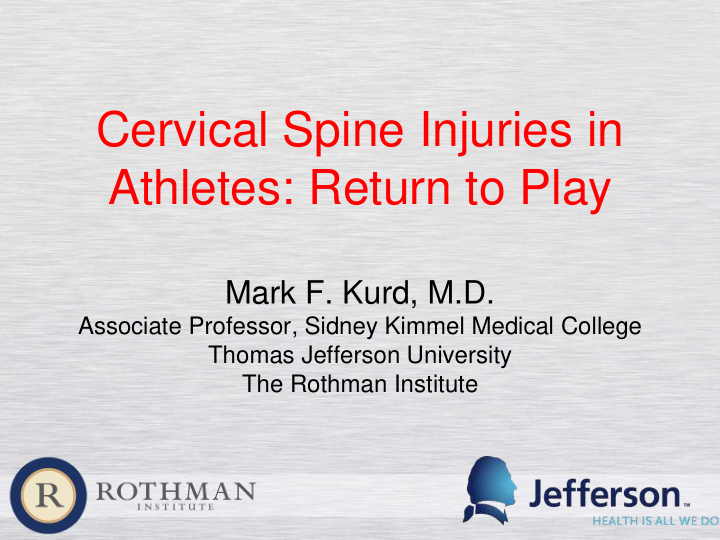



Cervical Spine Injuries in Athletes: Return to Play Mark F. Kurd, M.D. Associate Professor, Sidney Kimmel Medical College Thomas Jefferson University The Rothman Institute
Disclosures • Duratap, LLC: Shareholder
INCIDENCE 10-15% of all cervical spine injuries are sports related NEUROLOGIC INJURY 0.6-1.0%
NEURO INJURY Common with : • Football • Trampoline • Water sports • Gymnastics • Rugby • Ice Hockey • Wrestling
WATER SPORTS • Majority injuries to cervical spine
DIVING INJURIES Avg. Patient • Male, 13 yr or older • No formal diving training • 50% - alcohol involved
Axial Loading Injury in Hockey Number of catastrophic injuries low, BUT the incidence per 100,000 is high
Other Sports • Pole Vaulting – 2 catastrophic injuries/ 1 fatality per year, despite only 25,000-50,000 participants each year • Cheerleading – 0.6 direct catastrophic injuries per 100,000 • Baseball – 0.5 direct catastrophic injuries per 100,000 • Wrestling – 1.0 direct catastrophic injury per 100,000 Boden, JAAOS. 2005
FOOTBALL Associated with the highest number of severe head and neck injuries per year for all high school and college sports
Younger Athletes • High school football players – 3x more likely severe injury – 47 c spine injuries (2007-11) permanent disability/death • Triage, management, RTP criteria Boden et al. Am J Sport Med 2007 Meuller et al. UNC ann 2009
Spear Tackling • Most cervical injuries occurred to defensive players during tackling • Axial load mechanism identified in 27% of tackling injuries Cantu, Neurosurgery, 2000
Proper Technique: Heads Up Tackling • See What You Hit • Knees Bent at Impact • Drive Through with Legs
Gill et al, SMAR . 2008
Cervical Spine Syndromes • Cervical Sprain - ligamentous • Burners / Stingers - root or brachial plexus neuropraxia • Transient quadriplegia – Cervical Cord Neuropraxia (CNN) • Permanent quadriplegia - permanent disruption (axonotmesis, neurotmesis) of the cervical cord
BURNERS/STINGERS
Burners / Stingers • Pain, numbness & weakness. . . neck, arm, hand • 50% football players ! • Defensive players & offensive lineman Clinical Presentation
Differential Diagnosis Jogging off field with arm hanging down: • Burner / Stinger • Clavicle / AC injury • Glenohumeral . . . Subluxation/Dislocation
Mechanism • Lateral flexion away from involved side • Shoulder depression from blow • Brachial plexus stretch Mechanism of Injury
Management Burners/Stingers • Rule out more serious injury (red flags) – Bilateral symptoms •Restrict play, – Lower extremity •Immobilize – Persistent burning •Radiographic evaluation – Painful ROM – Tenderness • Multiple episodes and those likely due to root mechanism should be evaluated radiographically
RTP Burners/Stingers • 1 st Stinger – Resolutions of symptoms and painless ROM • 2 nd Stinger – Sit out game – Imaging • 3 rd Stinger – Sit out season Kepler et al, ClinSportsMed . 2012
Cervical Stenosis • Definitions – Canal diameter < 13mm (nl: 14-23) –Torg ratio <0.8 Torg JBJS 1986
Controversy • Abnormal Torg ratio – 3- fold increase in stingers –Low predictive value - no more susceptible to permanent neurologic injury than members of the general population (Torg)
Trauma/SCI • Quadriplegia • Cervical Cord Neuropraxia (CCN) • Transient (mins to hours) • Bilateral motor/sensory symptoms • Sensory symptoms: ● burning ● numbness ● loss of sensation
CCN Management • Analogous to concussion of the brain • RTP: full resolution of symptoms • Long-term effects of repeated episodes unknown
Cervical HNP • 99 NFL players identified (1979 – 2008) w CDH • 53 where treated operatively/46 nonop • Surgery – Greater percentage return to play (72% vs 46%) – More games played (29.3 vs 14.7) – Longer careers after injury (2.8 vs 1.5 yrs) • 5.3% of players required revision surgery for adjacent level disease Hsu WH. Spine. 2011
Cervical HNP When comparing NFL players with CDH those treated operatively had Greater percentage return to play (72% vs 46%) More games played (29.3 vs 14.7) Longer careers after injury (2.8 vs 1.5 yrs) 5.3% of players required revision surgery for adjacent level disease Hsu WH. Spine. 2011
Return to Play- ACDF • No cord compression • Symptoms resolved • Solid Fusion – One level – Two level-controversial – Three level-contraindicated Meredith DS. Am J Sports Med. 2013. Kepler CK. Clin Sports Med. 2012.
ACDF in Rugby • 19 professional players- ACDF between 1998- 2003 • Symptoms improved in 17 patients • 13 returned to play Andrews J et al. JBJS Br. 2008
RETURN to PLAY Absolute Contraindications • Cervical myelopathy • H/O C1-C2 fusion • C1-C2 hypermobility • Multi-level Klippel-Feil deformity • Spear Tacklers Spine • Lack of solid fusion s/p ACDF Proctor et al. Clin Sport Med 2012 Vaccaro et al. The Spine J. 2002.
RETURN to PLAY Absolute Contraindications • >2 previous episodes of CCN • S/P cervical laminectomy • Continued cervical discomfort, neuro deficit, or ↓ ROM Vaccaro et al. The Spine J. 2002.
RETURN to PLAY Relative Contraindications • H/O transient quadriplegia with full symptom resolution • Cord abnormality • 3+ stingers in same season • Stable, healed 2-level subaxial ACF or PCF Proctor et al. Clin Sport Med 2012 Vaccaro et al. The Spine J. 2002.
Conclusion • Limited data • Prevention: Heads up tackling • Appropriate on field management • Elite athletes can return to high level competition following ACDF • RTP: – Guidelines: Expert opinion – Complete resolution of symptoms
THANK YOU
Recommend
More recommend